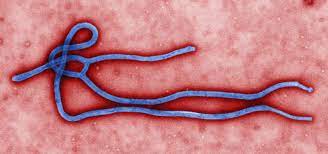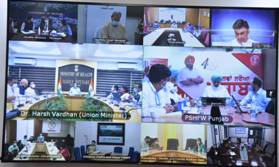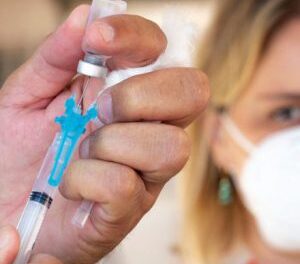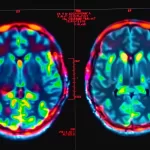Situation at a glance
Description of the situation
On 30 January 2025, the Ministry of Health of Uganda declared an outbreak of Sudan virus disease (SVD) following confirmation from three national reference laboratories.
The confirmed case was an adult male nurse who initially developed fever-like symptoms and sought treatment from a traditional healer as well as at multiple health facilities.
The patient presented with a history of high fever, chest pain, and difficulty in breathing with symptoms onset between 20 and 21 January, which later progressed to unexplained bleeding from multiple body sites. The patient experienced multi-organ failure and died at the National Referral Hospital on 29 January.
Samples taken post-mortem were confirmed for Sudan virus (SUDV).
Forty-five contacts have so far been identified, including 34 healthcare workers and 11 family members.
Epidemiology
Sudan virus disease is a viral hemorrhagic fever disease, belonging to the same family as Ebola virus disease. It is caused by Sudan virus (SUDV). It is a severe disease with high case fatality. It is typically characterized by acute onset of fever with non-specific symptoms/signs (e.g., abdominal pain, anorexia, fatigue, malaise, myalgia, sore throat) usually followed several days later by nausea, vomiting, diarrhoea, and occasionally a variable rash. Hiccups may occur. Severe illness may include hemorrhagic manifestations (e.g., bleeding from puncture sites, ecchymoses, petechiae, visceral effusions), encephalopathy, shock/hypotension, multi-organ failure, spontaneous abortion in infected pregnant women. Individuals who recover may experience prolonged sequelae (e.g., arthralgia, neurocognitive dysfunction, uveitis sometimes followed by cataract formation), and clinical and subclinical persistent infection may occur in immune-privileged compartments (e.g., CNS, eyes, testes). Person-to-person transmission occurs by direct contact with blood, other bodily fluids, organs, or contaminated surfaces and materials with risk beginning at the onset of clinical signs and increasing with disease severity. Family members, healthcare providers, and participants in burial ceremonies with direct contact with the deceased are at particular risk. The incubation period ranges from 2 to 21 days, but typically is 7–11 days.
Public health response
Health authorities are implementing public health measures, including but not limited to the following:
- The Ministry of Health (MoH) has activated the Incident Management Team and dispatched Rapid Response Teams to the affected district. The MoH team has also listed contacts at the National Reference Hospital.
- Regional Emergency Operation Centers are being activated in Kampala and the affected district.
- Facilities have been identified for quarantine of all listed contacts.
- MoH is organizing to carry out a safe and dignified burial of the patient.
- In their official press statement, the MoH provided recommendations to health workers, district leaders, and the public to strengthen detection of suspected cases and implement appropriate infection, prevention and control measures.
- MoH set up a hotline for notification of suspected cases.
WHO is supporting the national authorities, including through:
- Risk assessment and investigation.
- Providing operational, financial and technical support to the Ministry of Health to ensure swift response.
- Facilitating access to candidate vaccines and therapeutics
WHO risk assessment
Sudan virus disease (SVD) is a severe, often fatal illness affecting humans. Sudan virus (SUDV) was first identified in southern Sudan in June 1976. Since then, the virus has emerged periodically and up to now and prior to this current one, eight outbreaks caused by SUDV have been reported, five in Uganda and three in Sudan. The case fatality rates of SVD have varied from 41% to 70% in past outbreaks.
SUDV is enzootic and present in animal reservoirs in the region. Uganda reported five SVD outbreaks (one in 2000, one in 2011, two in 2012, and one in 2022). The current outbreak is the sixth SVD outbreak in Uganda. Uganda also reported a Bundibugyo virus disease outbreak in 2007 and an Ebola virus disease outbreak exported from the Democratic Republic of the Congo in 2019. The latest SVD outbreak in Uganda was declared over on 11 January 2023. A total of 164 cases with 77 deaths were reported in nine districts.
Uganda has experience in Ebola disease outbreaks including SVD, and necessary action has been initiated quickly.
In the absence of licensed vaccines and therapeutics for the prevention and treatment of SVD, the risk of potential serious public health impact is high. Community deaths, care of patients in private facilities and hospitals and other community health services as well as at traditional healers with limited protection and infection prevention and control measures entail a high risk of many transmission chains. An investigation is ongoing to determine the scope of the outbreak and the possibility of spread to other districts and potential exportation of cases to neighbouring countries cannot be ruled out at this stage.
WHO advice
Effective Ebola disease outbreak, including SVD, control relies on applying a package of interventions, including case management, surveillance and contact tracing, a good laboratory service, implementation of infection prevention and control measures in health care and community settings, safe and dignified burials and community engagement and social mobilization. Community engagement is key to successfully controlling outbreaks. Raising awareness of risk factors for infection and prevention measures that individuals can take is an effective way to reduce human transmission.
Early initiation of intensive supportive treatment increases the chances of survival. All above-mentioned interventions need to be thoroughly implemented in affected areas to stop chains of transmission and decrease disease mortality. Cases, contacts and individuals in affected areas who present signs and symptoms compatible with case definitions should be advised not to travel and seek early care at designated facilities to improve their chances of survival and limit transmission.
Collaboration with neighbouring countries should be enhanced to harmonize reporting mechanisms, conduct joint investigations, and share critical data in real-time. Surrounding countries should enhance readiness activities to enable early case detection, isolation and treatment.
A range of candidate vaccines and therapeutics are under different stage of development. In 2022, WHO convened expert deliberations to review candidate products prioritization and trial designs. One candidate vaccine and two candidate therapeutics (a monoclonal antibody and an antiviral) are available in country and will be made available through clinical trial protocol.
The two vaccines licensed against Ebola virus disease will not provide cross protection against SVD and cannot be used in this outbreak.
WHO advises against any restrictions on travel and/or trade to Uganda based on available information for the current outbreak.
Further information
- WHO African Region press release: WHO accelerates efforts to support response to Sudan virus disease outbreak in Uganda. https://www.afro.who.int/countries/uganda/news/who-accelerates-efforts-support-response-sudan-virus-disease-outbreak-uganda
- The Ministry of Health Uganda confirms the outbreak of Sudan virus disease: https://www.health.go.ug/cause/uganda-confirms-outbreak-of-sudan-ebola-virus-disease/
- Ebola virus disease fact sheet: http://www.who.int/en/news-room/fact-sheets/detail/ebola-virus-disease
- Optimized Supportive Care for Ebola Virus Disease. Clinical management standard operating procedures. WHO. 2019. https://www.who.int/publications/i/item/9789241515894#:s
- Ebola: technical guidance documents for medical staff (2014-2016). https://www.who.int/teams/health-care-readiness/ebola-clinical-management
- Safety of two Ebola virus vaccines: https://www.who.int/groups/global-advisory-committee-on-vaccine-safety/topics/ebola-virus-vaccines
- Personal protective equipment for use in a filovirus disease outbreak: rapid advice guideline: https://apps.who.int/iris/handle/10665/251426
- Framework and toolkit for infection prevention and control in outbreak preparedness, readiness and response at the national level: https://www.who.int/publications/i/item/framework-and-toolkit-for-infection-prevention-and-control-in-outbreak-preparedness–readiness-and-response-at-the-health-care-facility-level
- ICD-11 2022 release: https://www.who.int/news/item/11-02-2022-icd-11-2022-release
- New filovirus disease classification and nomenclature: https://www.ncbi.nlm.nih.gov/pmc/articles/PMC6637750/#SD1
- Sudan Ebolavirus – Experts deliberations Candidate treatments prioritization and trial design discussions, 2022: https://www.who.int/publications/m/item/sudan-ebolavirus—experts-deliberations.–candidate-treatments-prioritization-and-trial-design-discussions
- Considerations for border health and points of entry for filovirus disease outbreaks: https://www.who.int/publications/m/item/considerations-for-border-health-and-points-of-entry-for-filovirus-disease-outbreaks
Citable reference: World Health Organization (1 February 2025). Disease Outbreak News; Sudan virus disease in Uganda. Available at: https://www.who.int/emergencies/disease-outbreak-news/item/2025-DON555











